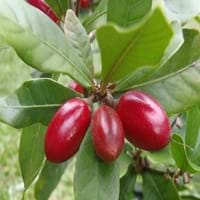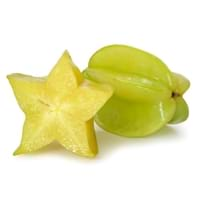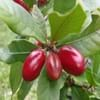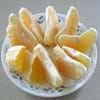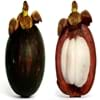Health Benefits
Good for diabetics, Improves well-being, Miraculin/miracle fruit makes sour things taste sweet
Cancer prevention, Heat stroke treatment
General Benefits
Has taste modifying effect
Anti oxidant properties, Anti-inflammatory properties, Digestive aid, Maintains healthy cholesterol level, Treatment of sore eyes
Skin Benefits
NA
Anti-aging benefits, Heals sunburn, Skin rejuvenation
Hair Benefits
NA
Promotes longer and healthier hair, Protects hair
Allergy Symptoms
Itching, Skin rash
NA
Side Effects
Changes taste of food eaten after this fruit, Coagulation
Nausea, Vomiting
Best Time to Eat
As a snack in the late afternoon, Eat the fresh ones, avoid mixing with any other foods, don't eat after meal., Morning time (before lunch)
As a snack in the late afternoon, Eat the fresh ones, avoid mixing with any other foods, don't eat after meal., Strictly avoid empty stomach
Protein to Carb Ratio
Not Available
Vitamin A (Retinol)
Not Available
Vitamin B1 (Thiamin)
Not Available
Vitamin B2 (Riboflavin)
Not Available
Vitamin B3 (Niacin)
Not Available
Vitamin B5 (Pantothenic Acid)
Not Available
Vitamin B6 (Pyridoxin)
Not Available
Vitamin B9 (Folic acid)
Not Available
Vitamin C (Ascorbic Acid)
Vitamin K (Phyllochinone)
Not Available
Lutein+Zeaxanthin
Not Available
Water Content
Not Available
Calories in Fresh Fruit with Peel
Not Available
Calories in Fresh Fruit without Peel
Not Available
Not Available
Calories in Frozen Form
Not Available
Not Available
Calories in Dried Form
Not Available
Calories in Canned Form
Not Available
Not Available
Calories in Juice
Not Available
Season
Monsoon
Autumn, Spring, Summer
Varieties
Gymnema Sylvestre and Thaumatococcus Daniellii
King, Bell, Sri Kembangan, Arkin and Fwang Tung
Color
Dark red
Golden yellow, Green
Inside Color
Greyish-white
Yellowish Green
Shape
Oval
Oval and Star(Cross section)
Taste
NA, Sweet
Crisp, Juicy, Sweet
Origin
West Africa
Sri Lanka
Grows on
Trees
Not Available
Soil Type
Well-drained
Loam, Well-drained
Climatic Conditions
Rainfall
Moist, Warm to hot climate
Facts about
- The name 'Miracle' because of the magical experience you get after eating it.
- When you have lemon after eating this fruit, it tastes sweet as if it is added with sugar.
- It is also used as natural sweetener.
- When carambola is cut horizontally, it forms a star.
- It is believed that carambola helps to cure hangover.
- Entire carambola is edible, including its skin.
- 2 varieties of carambola are cultivated: tart & sweet.
Other Countries
NA
Australia, Guyana, India, Israel, Malaysia, Philippines, United States of America
Top Importer
Not Available
Europe
Top Exporter
United States of America
Malaysia
Botanical Name
Synsepalum Dulcificum
Averrhoa carambola
Synonym
Miracle Berry, Miraculous Berry and Sweet Berry
Not Available
Subkingdom
Tracheobionta
Tracheobionta
Division
NA
Magnoliophyta
Subclass
Asteridae
Rosidae
Order
Ericales
Oxalidales
Family
Sapotaceae
Oxalidaceae
Genus
Synsepalum
Averrhoa
Species
S. dulcificum
A. carambola
Generic Group
Not Available
Not Available
Difference Between Miracle fruit and Carambola
We might think that Miracle fruit and Carambola are similar with respect to nutritional value and health benefits. But the nutrient content of both fruits is different. Miracle fruit and Carambola Facts such as their taste, shape, color, and size are also distinct. The difference between Miracle fruit and Carambola is explained here.
The amount of calories in 100 gm of fresh Miracle fruit and Carambola with peel is Not Available and 31.00 kcal and the amount of calories without peel is Not Available and Not Available respectively. Thus, Miracle fruit and Carambola belong to Low Calorie Fruits and Low Calorie Fruits category.These fruits might or might not differ with respect to their scientific classification. The order of Miracle fruit and Carambola is Ericales and Oxalidales respectively. Miracle fruit belongs to Sapotaceae family and Carambola belongs to Oxalidaceae family. Miracle fruit belongs to Synsepalum genus of S. dulcificum species and Carambola belongs to Averrhoa genus of A. carambola species. Beings plants, both fruits belong to Plantae Kingdom.
